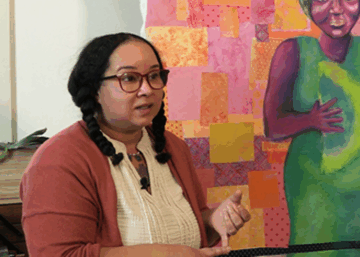
A Storyteller who finds rhythm in fabric
Self-taught artist and multi-media storyteller rosy petri was born and raised in Milwaukee. But her love for working with fabric as a medium for her art is deeply rooted in the South and her family history.
“Both of my grandmothers were quilters,” petri shared. “One was a very traditional piecing quilter. She did Baltimore album quilts and things like that. My other grandmother did Southern style improvisational patchwork quilts.”
While neither of her grandmothers taught her how to quilt, watching them inspired her to start experimenting with textures and printmaking as a way to tell stories.
“When working with fabric, all bets are off,” according to petri. “That can be really fun, really spontaneous. You can add textures with things like yarn, different types of threads. It is really wide open.”
For Baird Center, petri has created a triptych titled Moanin’ in Muddy Waters: The Blues Women of Paramount Records. The pieces tell the early days of the blues through the lens of Paramount Records located in Grafton, Wisconsin. During the 1920s and 1930s, some would argue that Paramount was the epicenter of the blues as they produced of several of the most significant blues albums of all time.
Sadly, Paramount’s history was short lived. Despite having a star-studded roster of African American blues musicians and singers, including Ma Rainey, Jelly Roll Morton, Blind Lemon Jefferson and Ida Cox, Paramount closed sometime in the mid-1930s as a result of the Great Depression. Legend has it that angry laid off employees took the recordings and tossed them into the Milwaukee River after learning they had lost their jobs resulting in the master recordings being lost forever.
An additional underling theme of petri’s works is the story of the tale of the Great Migration. One of the largest movements of people in the history of the United States, millions of Black people moved from the South to the North, Midwest and West to escape the racial violence and oppression of Jim Crow laws.
“The pieces are sequential and they tell a story,” petri stated. “They tell a story of promise. They tell a story of travel and migration. And they tell a story of heartache.”
petri uses hand dyed fabric stretched over canvas as her storytelling tools. Borrowing from the traditions of African wax and batik printing, she experimented with the use of dust, dirt and pigments, some sourced from her home garden, in the creation of the works. petri begins the series with softer shades of pink and sherbet to symbolize the hopefulness of the early stages of the migration where queer black women were performing and doing things they were not allowed to do in the South. As the series progresses the colors grow darker and more ominous, showing the reality of danger and sunset towns that awaited them in the North.
While she hopes visitors to Baird Center enjoy the works for their own sake, she also hopes that they walk away with wanting to find out more.
“I hope that people seeing the series have questions and I hope their questions encourage them to find out what happened,” petri stated. “It is important because it is about the roots of American music. It is important for Black culture and the history of Black people in and around Milwaukee.”